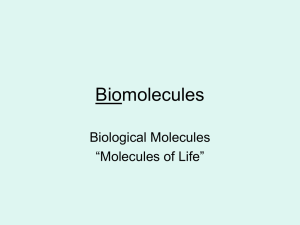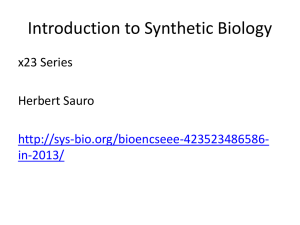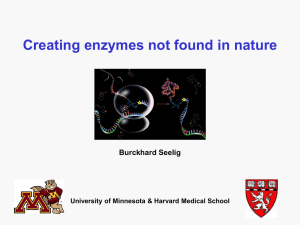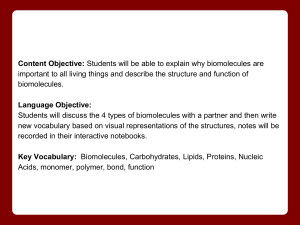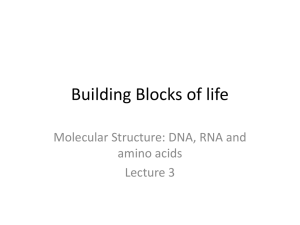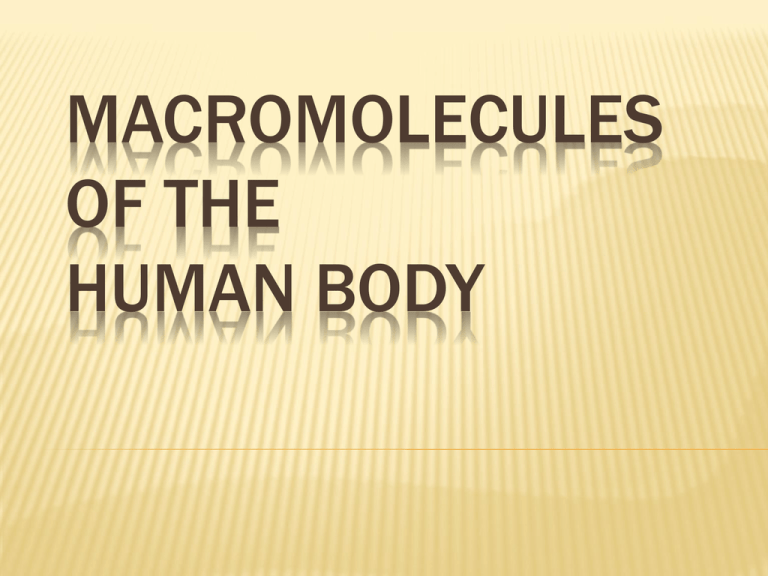
MACROMOLECULES
OF THE
HUMAN BODY
TYPES OF MACROMOLECULES
Carbohydrates
Proteins
Lipids (Fats)
Nucleic Acids
MACROMOLECULE 1: CARBOHYDRATES
Carbohydrates contain 3 elements: C, H, and O
These elements are found in a 1:2:1 ratio
Carbohydrate
Carbo = Carbon (C)
Hydrate = Water (H20)
C H20 = C, H, and O in a 1:2:1 ratio
CARBOHYDRATES ARE COMPOSED OF RINGS OF
CARBON, HYDROGEN, AND OXYGEN
CARBOHYDRATES: MONOSACCHARIDES
Monosaccharides
Mono
= one
saccharide = sugar
Characteristics of a Monosaccharide
Are
the simplest sugars
Are single ring structures
Typically have a chemical formula C6H12O6
EXAMPLES OF MONOSACCHARIDES
Glucose
Glucose, fructose, and galactose are all monosaccharides with the chemical
formula C6H12O6.
Isomer – substances that have the same chemical formula, but a different
structural formula
EXAMPLES OF MONOSACCHARIDES
Deoxyribose (C5H10O4) and Ribose (C5H10O5) are not true isomers as they do
not have the exact same chemical or structural formulas.
Can you find the difference in the structural formulas of deoxyribose and
ribose?
How do you suppose deoxyribose got it’s name?
CARBOHYDRATES: DISACCHARIDES
Sucrose = table sugar
Lactose = milk sugar
Maltose = malt sugar (barley products)
DISACCHARIDE FORMATION
Disaccharides are the result of the connection
of two monosaccharides by dehydration
synthesis.
DEHYDRATION SYNTHESIS EQUATION
C6H12O6 + C6H12O6 = C12H22O11 + H2O
C12H22O11 + C12H22O11 = C24H42O21 + H2O
C24H42O21 + C24H42O21 = C48H82O41 + H2O
CARBOHYDRATES: POLYSACCHARIDES
Polysaccharides are the result of connection of
many monosaccharides by dehydration
synthesis.
The general formula for polysaccharides can
also be represented as (C6H10O5)n where
40≤n≤3000
Examples of polysaccharides are starch
(plants/energy), glycogen (animals/energy),
cellulose (plants/fiber), and chitin
(animals/fungi/protection)
POLYSACCHARIDES: STARCH
Starches are glucose polymers. Amylose starches
consists of a linear chain of several hundred
glucose molecules and Amylopectin starches are a
branched molecule made of several thousand
glucose units (every chain 24–30 glucose unit).
Starches are insoluble in water. They can be
digested by hydrolysis, catalyzed by enzymes
called amylases. Humans and other animals have
amylases, so they can digest starches. Potato, rice,
wheat, and corn are major sources of starch in the
human diet. The formation of starches are the way
that plants store glucose.
POLYSACCHARIDES: GLYCOGEN
Glycogen is a polysaccharide that is found in
animals and is composed of a branched chain
of glucose residues. It is stored in liver and
muscles.
POLYSACCHARIDES ILLUSTRATED
CELLULOSE
The structural component of plants are formed
primarily from cellulose. Wood is largely cellulose
and lignin, while paper and cotton are nearly pure
cellulose. Cellulose is a polymer made with
repeated glucose units bonded together. Humans
and many other animals lack an enzyme to break
these linkages, so they do not digest cellulose.
Certain animals can digest cellulose, because
bacteria possessing the enzyme are present in
their gut. The classic example is the termite.
CHITIN
Chitin is one of many naturally occurring polymers.
It is one of the most abundant natural materials in
the world. Over time it is bio-degradable in the
natural environment. Its breakdown may be
catalyzed by enzymes called chitinases, secreted
by microorganisms such as bacteria and fungi, and
produced by some plants. Some of these
microorganisms have receptors to simple sugars
from the decomposition of chitin. If chitin is
detected, they then produce enzymes to digest it
by cleaving the glycosidic bonds in order to convert
it to simple sugars and ammonia.
CARBOHYDRATES IN FOOD
Fruits
Vegetables
Nuts
Grains
Seeds/Nuts
Pasta
FUNCTIONS OF CARBOHYDRATES
Providing energy and regulation of blood
glucose
Sparing the use of proteins for energy
Breakdown of fatty acids and preventing
ketosis (use of cellular glycogen for energy)
Biological recognition processes
Flavor and Sweeteners
Dietary fiber
MACROMOLECULE 2: PROTEINS
Proteins contain the elements carbon,
hydrogen, oxygen, nitrogen, and sometimes
sulfur
PROTEINS AND AMINO ACIDS
Proteins are composed of amino acids linked
together by dehydration synthesis
AMINO ACIDS AND R-GROUPS
THE PEPTIDE BOND
POLYPEPTIDES VS. PROTEINS
Polypeptide is a single linear chain of amino
acids bonded together by peptide bonds.
PROTEINS VS. POLYPEPTIDES
Protein molecules
consist of one or
more
polypeptides put
together typically
in a biologically
functional way.
PROTEIN STRUCTURE
FUNCTIONS OF PROTEINS
Required for building and repair of body tissues (including
muscle)
Enzymes, hormones, and many immune molecules are
proteins
Essential body processes such as water balancing, nutrient
transport, and muscle contractions require protein to
function.
Protein is a source of energy.
Protein helps keep skin, hair, and nails healthy.
Protein, like most other essential nutrients, is absolutely
crucial for overall good health
PROTEINS AS ENZYMES
The best-known role of proteins in the cell is as
enzymes, which catalyze chemical reactions.
Enzymes are usually highly specific and
accelerate only one or a few chemical
reactions. Enzymes carry out most of the
reactions involved in metabolism, as well as
manipulating DNA in processes such as DNA
replication, DNA repair, and transcription.
PROTEINS IN FOOD
Red meat
Chicken
Fish
Pork
Eggs
Dairy
Beans
Nuts
Seeds
MACROMOLECULE 3: LIPIDS
Lipids are also known as fat
Lipids may contain the elements C, H, O, N, P
The main lipid consumed in vegetable oil and
animal fats is a triglyceride.
Triglycerides are composed of 3 (tri) fatty acids
and one glycerol (glyceride).
TRIGLYCERIDE FORMATION:
DEHYDRATION SYNTHESIS
FUNCTIONS OF LIPIDS
The main biological functions of lipids include
energy storage and as structural components
of cell membranes (phospholipids).
LIPIDS IN FOOD
Meats
Dairy
Pastries
Oils
Dressings
Processed foods
Fast foods
MACROMOLECULE 4: NUCLEIC ACIDS
There are two nucleic acids:
Deoxyribonucleic
acid (DNA)
Ribonucleic acid (RNA)
Nucleic acids contain the elements C, H, O, N, P
NUCLEIC ACIDS AND NUCLEOTIDES
DNA and RNA are composed of nucleotides
Nucleotides are composed of a sugar, a
phosphate group, and a nitrogenous base
DNA
DNA nucleotides are composed of the sugar
deoxyribose, phosphoric acid, and one of four
nitrogenous bases
The four nitrogenous bases of DNA are Adenine
(A), Cytosine (C), Thymine (T), and Guanine (G)
Adenine forms two hydrogen bonds with
Thymine
Guanine forms three hydrogen bonds with
Cytosine
DNA
RNA
RNA nucleotides are composed of the sugar
ribose, phosphoric acid, and one of four
nitrogenous bases
The four nitrogenous bases of DNA are Adenine
(A), Cytosine (C), Uracil (U), and Guanine (G)
Adenine bonds with Uracil
Guanine bonds with Cytosine
RNA is a single stranded molecule
DNA VS. RNA
DNA REPLICATION
In order for a cell to
divide during the
processes of mitosis
(body cells) or meiosis
(sex cells), the cell
must first replicate
(duplicate) it’s DNA.
TRANSCRIPTION: DNA TO RNA
Transcription: the
process of making
RNA from the DNA
found within the
nucleus of a
eukaryotic cell
TRANSLATION: RNA TO PROTEINS
Translation: the process of
making proteins from RNA
within the cytoplasm of the
cell
TRANSLATION: RNA TO PROTEINS
MONOMERS AND POLYMERS
Polymer: a large molecule (macromolecule) composed of
repeating structural units
Monomer: a small molecule that may bind chemically to other
monomers to form a polymer
MACROMOLECULE
POLYMERS
MONOMERS
Carbohydrates
Polysaccharides
Monosaccharides
Proteins
Proteins/Polypeptides
Amino Acids
Lipids
Triglycerides/Phospholipids
Glycerol + Fatty Acids
Nucleic Acids
DNA and RNA
Nucleotides
MACROMOLECULES
DIGESTION OF MACROMOLECULES
In order for the human body to utilize the
macromolecules it consumes in a meal, it must
first break down the nutrients into their simplest
form, monomers!
This process is achieved in the digestive system by
way of enzymes
Once the macromolecules are broken into
monomers they can be absorbed into the blood
stream and transported to the cells where they will
continue to perform their functions
DIGESTION, ENZYMES, AND HYDROLYSIS
Digestion is controlled by enzymes (specialized
proteins)
Enzymes
are biological catalysts
Catalysts initiate or speed up a reaction without
becoming part of the reaction
Proenzymes – inactive enzyme precursor
Digestion is accomplished by hydrolysis
Hydrolysis is the opposite of dehydration
synthesis
DIGESTION, ENZYMES, AND HYDROLYSIS
Hydrolysis: Hydrolysis is a chemical process in
which a certain molecule is split (lysis) into two
parts by the addition of a molecule of water
(hydro).
One fragment of the parent molecule gains a
hydrogen ion (H+) from the additional water
molecule.
The other group collects the remaining hydroxyl
group (OH−).
HYDROLYSIS OF TABLE SUGAR
THE PROCESS OF DIGESTION VIDEO
The Enzymes of Digestion
(2:46)
http://www.youtube.com/watch?v=AEsQxzeAry8
DIGESTIVE ENZYMES
Carbohydrates
DIGESTIVE ENZYMES
Proteins
DIGESTIVE ENZYMES
Lipids and Nucleic Acids
Pancreatic nuclease enzymes digest nucleic acids (DNA and RNA) to
nucleotides in the duodenum.
Membrane-bound nucleotidase enzymes in the epithelial cells of the ileum
digest the nucleotides to sugar, base and phosphate, which are absorbed.
ENZYMES IN ACTION
MICELLE
LACTEAL
CHYLOMICRONS
Lipoproteins:
85-92% triglycerides, 6-12% phospholipids, 1-3% cholesterol, 1-2% proteins

